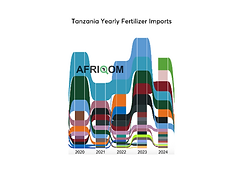Executive Summary
Tanzania’s fertiliser subsidy programme, launched in August 2022 to boost productivity, is now imposing a systemic liquidity squeeze on the input supply chain. As of June 2024, the government owes TZS 204 billion to 19 companies that collectively delivered 901,334 tonnes of fertiliser. Despite TZS 490 billion budgeted for 2022–2025, delayed reimbursements are forcing suppliers to pre-finance imports, absorbing FX and credit risks. With domestic production covering less than 15% of demand, this structural strain threatens national input availability ahead of the 2025/26 season.
Key Data Points
· Agriculture share of GDP / employment: 26.5% / 65%
· Maize yield: 1.9 t/ha (vs Egypt 9 t/ha; Zambia 4.2 t/ha)
· Fertiliser use: 24 kg/ha (vs CAADP 50 kg/ha target)
· Subsidy allocations:
o FY2022/23: TZS 150bn
o FY2023/24: TZS 137bn
o Total budgeted (2022–2025): TZS 490bn
· Outstanding arrears: TZS 204bn to 19 companies
· Distribution network: 31 licensed suppliers; 4,200+ regional agents
· Logistics: ~40% of fertiliser cost; high leakage risk
So far
1- Great Reactivity:
The Tanzanian government acted decisively by rolling out an emergency price subsidy across the entire country—delivering exactly what was needed: shielding national input supply and preserving food security. Fertilizer imports in 2022 were effectively protected from the global price spike, enabling growth at a time when many African peers saw contraction
2- Procurement Flexibility:
With strong intent and strategic foresight, Tanzania placed its Bulk Procurement System (BPS) on standby, allowing importers and distributors to bypass the tendering process and import directly. This agility enabled market participants to respond in real time to shifting global supply conditions and price movements.
3- Emerging Contraction:
However, by 2024, the financial weight of the universal subsidy began to show. Despite early success, the market has since experienced a contraction—driven by arrears, liquidity constraints, and growing uncertainty across the supply chain.



Risk Transmission Channels
1. Liquidity & Credit Risk
o Suppliers face working capital stress, rolling over expensive debt
o Increased probability of defaults and banking sector NPLs
2. Import Risk
o Pre-financing disruptions may thin inventories ahead of planting season
o FX mismatch risk heightened as importers delay shipments
3. Price Risk
o Sustained arrears and financing cost pass-through may drive abrupt retail price increases if subsidies taper off
4. Governance Risk
o Delays in TFRA verification and weak digital tracking amplify payment delays
Scenarios (12–18 months)
Scenario A (30% likelihood): Rapid arrears clearance + shift to targeted e-vouchers: Stabilised supplier liquidity, reduced fiscal cost, better allocation.
Scenario B (45% likelihood): Status quo (partial payments, no reform): Inventory stress, margin compression, potential farmgate shortages.
Scenario C (25% likelihood): Fiscal retrenchment (subsidy freeze or cut): Retail price shock, demand collapse, consolidation in input supply.
Policy Recommendations
· Shift to e-voucher targeting: Focus on strategic crops and regions; ensure digital farmer verification
· Issue tradeable arrear notes: Provide liquidity relief to suppliers without upfront cash requirement
· Return to BPS Procurement: Switch back to bulk procurement with overhauled procurement process to ride global volatility and offer best margins to distributers and farmers
· Publish monthly cash flow calendar: Transparency on approvals, claims, and payouts to de-risk lending
· Reallocate funding: prioritize Smallholder farmers, promote irrigation, road access, and extension services over untargeted subsidies
· Digitise input delivery: End-to-end tracking to reduce ghost deliveries and verification lag
Market Signals to Watch
· Global price trend movement
· TFRA reimbursement cycle time (DSO)
· YoY import volume comparison ahead of 2025/26
· Tanzania fertilizer forecast Outlook
· FY2025/26 budget amendments to fertiliser allocations
· Private sector borrowing costs and NPL rates in agri portfolios
· Importer exit/entry or M&A activity in the input space
Bottom Line for Stakeholders
Subsidy design, not intent, is the constraint. Tanzania can deliver input security with lower fiscal exposure by pivoting to smart, digitally verified subsidies and clearing arrears promptly. As arrears deepen, donors, lenders and development agencies must prioritise policy-linked liquidity mechanisms to avoid systemic disruption.
AFRIQOM Market Reporter

